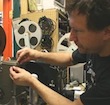|
Author
|
Topic: Curling Pathescope Film
|
|
|
|
|
|
|
|
|
|
|
Dino Everette
Phenomenal Film Handler

Posts: 1535
From: Long Beach, CA USA
Registered: Dec 2008
|
 posted October 08, 2017 10:43 PM
posted October 08, 2017 10:43 PM



My opinion is that it is a combination of the fact that old films experience shrinkage, and that they are inside metal cassettes, which will amplify the heat on the film which has been stored in environments that switch from cold to hot conditions. I have seen hundreds of 16mm prints that have been stored in warmer conditions over the years and they exhibit the same sort of "permanent" curl...Basically storing films in cans in houses that have varying temperatures throughout the years can be risky, as the metal cans amplify the changes...At work I once came across the greatest single longterm test case ever....It was a box of 35mm trailers that came straight from the lab in 1973 to the person's house. The person stuck the box in their closet and it sat there for 45 years until we picked it up at the archive. Inside the box were 12 copies of a trailer, 11 of which were in metal cans, and one was in a cardboard box..The 11 were all terribly deteriorated with extreme vinegar syndrome, brittle and shrunken, and the one in the box was in perfect condition...Metal is great for archives that store films in the cold, but terrible for the home, which may have large temperature changes throughout the year...The boxes breathe in such an environment where the metal cans just work harder to ruin the film by increasing the change in temperature. If the house is 75 degrees, it is probably 80+ inside the can, or if the house is 60 it is probably 55- in the can...in the archive it is the opposite because the boxes can easily develop mold or problems if the air quality is not kept dry...
--------------------
"You're too Far Out Miss Lawrence"
| IP: Logged
|
|
|



 UBBFriend: Email this page to someone!
UBBFriend: Email this page to someone!
 Printer-friendly view of this topic
Printer-friendly view of this topic



 UBBFriend: Email this page to someone!
UBBFriend: Email this page to someone!
 Printer-friendly view of this topic
Printer-friendly view of this topic